 How to spend a Sunday morning? How about sitting outdoors drinking cup after cup of extravirgin olive oil.
How to spend a Sunday morning? How about sitting outdoors drinking cup after cup of extravirgin olive oil.
That’s exactly what our newest Food and Wine group did yesterday, celebrating their first full day with us in Umbria. And what Food and Wine tour would be complete here in Umbria without a visit to a frantoio, or olive mill, especially during the traditional October harvest season?
Each of the past five years we have featured the olive harvest as one of the highlights of our October tours, arranging visits to some of the Umbrian producers who supply Bella Italia with delicious, peppery extravirgin olive oil throughout the year. And although our recently arrived group was not an “official” food and wine tour, but an ad hoc group that wanted us to accompany them and give them a backstage pass to Umbria, their arrival during the second week of October, after the traditional start of the olive harvest on St. Francis Feast Day (October 4) meant that they would likely be able to watch the olives being brought in from the fields and crushed and spun until bright green oil emerged from the extraction machinery.
But a funny thing happened this year, way back in July and August. It was hot as Hell and dry. This summer’s unusually dry, hot weather, in fact, resulted in a number of wild fires on the hills around Umbria, an unusual phenomenon for a country used to hot summer weather. But in addition to scorching the countryside, it retarded the growth and maturation of the region’s olives, stunting their growth and delaying the harvest. Now the cooler, wetter weather threatens to cause even more harm, as dry, warm conditions are the preferred environment during the harvest.
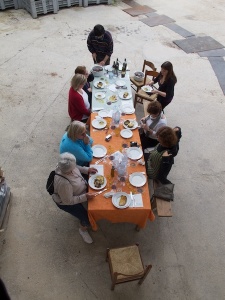 So on Sunday morning we arrived at the Alberto Cipolloni frantoio or olive mill expecting not an insider’s glimpse into the oil harvest but instead a brief tour of the idle facilities and a sampling of Cipolloni’s award winning olive oils. This brief visit, however, turned into an hours long extravaganza of hospitality and olive oil education. It was, yet again, a memorable day.
So on Sunday morning we arrived at the Alberto Cipolloni frantoio or olive mill expecting not an insider’s glimpse into the oil harvest but instead a brief tour of the idle facilities and a sampling of Cipolloni’s award winning olive oils. This brief visit, however, turned into an hours long extravaganza of hospitality and olive oil education. It was, yet again, a memorable day.
We were greeted at the frantoio by the owner, Carlo Pagliacci and his English speaking associate Lucio Maltempi. We have paid a couple of dozen visits to the frantoio with them over the years, after a day nearly five years ago when they drove up to our villa to introduce themselves and their oils to us. On that day we sampled their oils, including their traditional Umbrian blend of moraiolo, frantoio and lecchino olives. It was love at first slurp.
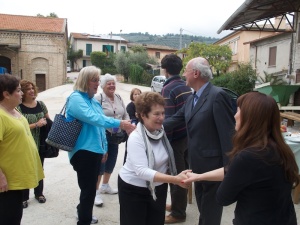 So the pair greeted our group for our late morning arrival, Dr. Pagliacci dressed, as always, in a suit jacket and Lucio more casual in Italian fashion. Since the pressing machinery would not be operating today and the loading area would be vacant, they set up a long table for us outdoors for us to sit at and sample their oils, both on their own and with certain foods. But before we sat to taste, Lucio gave us a tour of the processing facilities.
So the pair greeted our group for our late morning arrival, Dr. Pagliacci dressed, as always, in a suit jacket and Lucio more casual in Italian fashion. Since the pressing machinery would not be operating today and the loading area would be vacant, they set up a long table for us outdoors for us to sit at and sample their oils, both on their own and with certain foods. But before we sat to taste, Lucio gave us a tour of the processing facilities.
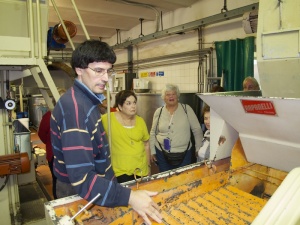 He walked us through the various machines, showing us where freshly picked olives are loaded into the first machine, which transports them and shakes the fruit from any branches and leaves, recycling the refuse for use on the fields while transporting the separated olives to the washer. There a bath of water cleans the olives and sends them to the first phase of processing, the crushing.
He walked us through the various machines, showing us where freshly picked olives are loaded into the first machine, which transports them and shakes the fruit from any branches and leaves, recycling the refuse for use on the fields while transporting the separated olives to the washer. There a bath of water cleans the olives and sends them to the first phase of processing, the crushing.
The heart of the Cipolloni process involves two distinct crushing processes carried out a single machine designed in nearby Foligno. A portion of the olives are sent to a machine with large blades that slice and cut the olives, the working back and forth of the fruits resulting in the creation of droplets of oil that drip to the bottom of the machine and are sent to a centrifuge at the end of the line. This portion of oil is the most fragrant and aromatic and will be mixed together with the second portion of oil that is being processed from the remainder of the olives. This portion processes the paste that results from the initial slicing, and hundreds of kilos of olive sludge is worked with a giant screw that kneads the paste and coaxes out the oil from it. That oil, which is the “healthy” component of the oil – rich in polyphenols and other nutrients that give extravirgin olive oil its legendary health benefits – contains a high level of olive water, which is separated from the oil by another machine. The resulting second portion is centrifuged and emerges from a stainless steel spigot – like the first portion – and then blended back together. We have accompanied groups to the frantoio while the machines are running and the look on our guests faces when they are offered a plastic spoon to put under the spigot and given an opportunity to taste the green gold as it pours from the machine, is priceless.
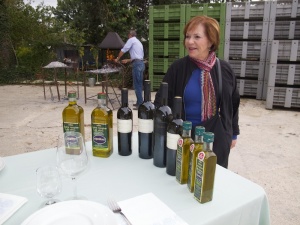 But today our group does not get to experience the fresh oil running from the machine. Today the machines are idle, waiting perhaps one more week before Carlo and Lucio decide that this year’s crop is ripe enough to begin harvesting. But in place of drinking freshly pressed oil, we get Carlo and Lucio’s undivided attention to explaining the process to us and to teaching us how to taste and appreciate olive oil. And with the equipment not clanging, we are able to hear them clearly for the first time.
But today our group does not get to experience the fresh oil running from the machine. Today the machines are idle, waiting perhaps one more week before Carlo and Lucio decide that this year’s crop is ripe enough to begin harvesting. But in place of drinking freshly pressed oil, we get Carlo and Lucio’s undivided attention to explaining the process to us and to teaching us how to taste and appreciate olive oil. And with the equipment not clanging, we are able to hear them clearly for the first time.
So after the explanation and tour of the machinery we are brought back outside to the makeshift outdoor tasting room that they have set up for us. It is a lovely table in a most authentic place – within view of the machinery we have just visited, and right in the middle of the loading area where olives are brought from the fields, the scene surrounded by colorful empty plastic bins that next week will be overflowing with freshly picked olives.
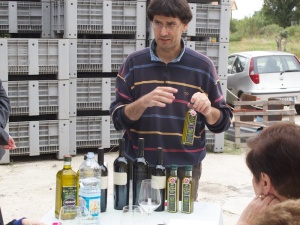 Lucio begins the tasting by describing their entire line of olive oils – from olio novello that is pressed from the early harvest, the immature olives yielding a fruitier, intense taste that is ideal for flavoring foods, to their standard Umbrian blend of moriaolo, frantoio and lecchino (in both filtered and unfiltered varieties), big bottles of 100% moraiolo olive oil, the more intense and most typically Umbrian varietal, and two signature products, a white and a black label variety made from olives from specific fields, typically from the higher elevations of this farm that numbers over 35,000 olive trees. He passes us small plastic cups of oil and
Lucio begins the tasting by describing their entire line of olive oils – from olio novello that is pressed from the early harvest, the immature olives yielding a fruitier, intense taste that is ideal for flavoring foods, to their standard Umbrian blend of moriaolo, frantoio and lecchino (in both filtered and unfiltered varieties), big bottles of 100% moraiolo olive oil, the more intense and most typically Umbrian varietal, and two signature products, a white and a black label variety made from olives from specific fields, typically from the higher elevations of this farm that numbers over 35,000 olive trees. He passes us small plastic cups of oil and 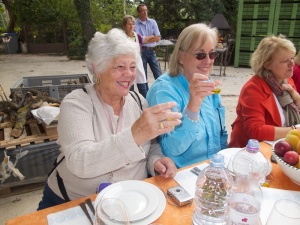 teaches us the art of strippaggio or slurping olive oil in order to isolate the multitude of flavors that are present in extravirgin olive oil. As always, it is a hoot to see our guests struggling not to look silly while making loud slurping noises and fighting back the coughing that usually accompanies ingesting piquante olive oil.
teaches us the art of strippaggio or slurping olive oil in order to isolate the multitude of flavors that are present in extravirgin olive oil. As always, it is a hoot to see our guests struggling not to look silly while making loud slurping noises and fighting back the coughing that usually accompanies ingesting piquante olive oil.
After tasting the entire range of oils raw, massive plates of raw vegetables – fresh fennel, sliced carrots and sticks of celery – were passed, along with individual bowls of EVOO heavily spiced with fresh ground pepper and salt. This simple crudité platter, known in Italy as pinzimonio is an excellent way to taste and appreciate olive oil and is an extremely tasty antipasto.
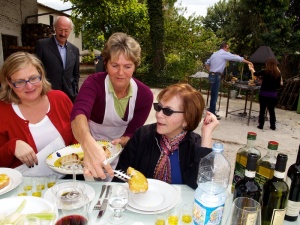 Carlo’s assistants then pass around a large platter of bread that has been toasted in the open air barbeques that have been set up for our tasting. Thick slices of bread have been slathered with Cipolloni oil after having been perfumed with a tiny bit of garlic, then finished with a pinch or two of salt. It is one of my very favorite treats and I can think of few ways better to enjoy a great olive oil.
Carlo’s assistants then pass around a large platter of bread that has been toasted in the open air barbeques that have been set up for our tasting. Thick slices of bread have been slathered with Cipolloni oil after having been perfumed with a tiny bit of garlic, then finished with a pinch or two of salt. It is one of my very favorite treats and I can think of few ways better to enjoy a great olive oil.
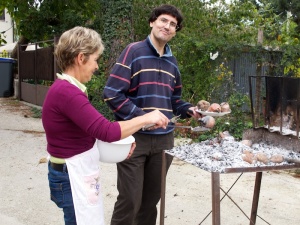 But after a slight pause, during which our attention shifts to the local red wine, a Montefalco Rosso from the nearby Colpetrone vineyard, Carlo and Lucio answer that question (i.e,. what better ways are there to enjoy a great olive oil other than slathered on toasted bread). The answer is to slather it on roasted potatoes and onions. For while we have been touring the facilities and learning the art of slupring, those outdoor barbeques have been quietly going about their business, the business of roasting potatoes and onions underneath the great mounds of coals and ashes that have been piled up in the bottom of the grill. With great fanfare and flourish Lucio retrieves the hidden gems from the ashes and slices them in half, giving each of us a plate with a half potato and a half onion. He completes the scene by submerging each in a pool of olive oil.
But after a slight pause, during which our attention shifts to the local red wine, a Montefalco Rosso from the nearby Colpetrone vineyard, Carlo and Lucio answer that question (i.e,. what better ways are there to enjoy a great olive oil other than slathered on toasted bread). The answer is to slather it on roasted potatoes and onions. For while we have been touring the facilities and learning the art of slupring, those outdoor barbeques have been quietly going about their business, the business of roasting potatoes and onions underneath the great mounds of coals and ashes that have been piled up in the bottom of the grill. With great fanfare and flourish Lucio retrieves the hidden gems from the ashes and slices them in half, giving each of us a plate with a half potato and a half onion. He completes the scene by submerging each in a pool of olive oil.
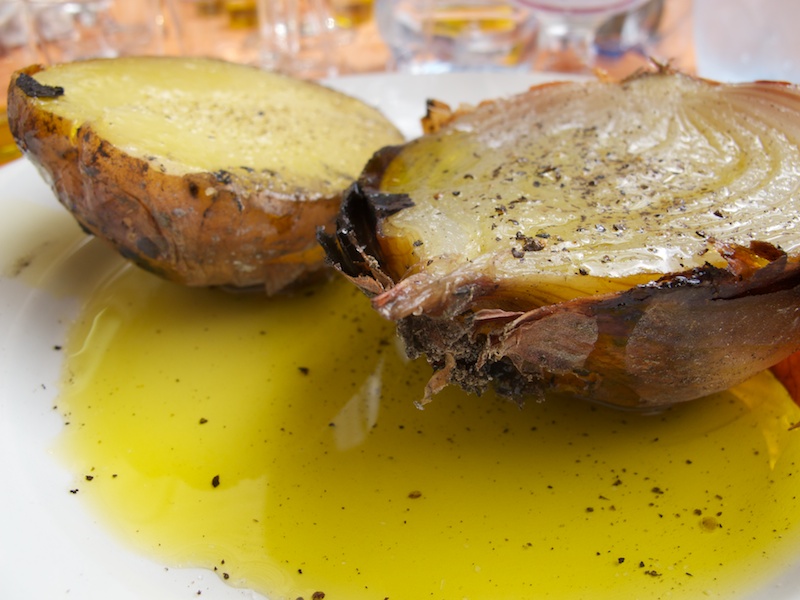 The effect is incredible. The hot flesh of the potato is made richer by the cool, fruity viscosity of the olive oil, a combination of tastes, textures and temperatures that is divine. And the onion is even better with its firm crunchiness, each bite revealing bitterness and sweetness that is encapsulated by the earthy, grassiness of the oil. It is hard to imagine anything simpler or better.
The effect is incredible. The hot flesh of the potato is made richer by the cool, fruity viscosity of the olive oil, a combination of tastes, textures and temperatures that is divine. And the onion is even better with its firm crunchiness, each bite revealing bitterness and sweetness that is encapsulated by the earthy, grassiness of the oil. It is hard to imagine anything simpler or better.
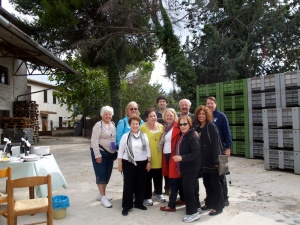 And that is the essence of a day like today, the secret of life in Italy. Simplicity – a wooden table set outdoors in a work area, a morning spent talking about a single thing – olive oil, a potato roasted in a pile of cinders – need not be and never is boring. It is inspiring. Inspiring to know that great pleasure and great discovery can come from simple things and that we need not waste our time chasing after the complex, the glitzy, because contained inside the simple is an incredible reservoir of wellbeing, which can bring us great pleasure and happiness if we only learn how to release it, how to tap it.
And that is the essence of a day like today, the secret of life in Italy. Simplicity – a wooden table set outdoors in a work area, a morning spent talking about a single thing – olive oil, a potato roasted in a pile of cinders – need not be and never is boring. It is inspiring. Inspiring to know that great pleasure and great discovery can come from simple things and that we need not waste our time chasing after the complex, the glitzy, because contained inside the simple is an incredible reservoir of wellbeing, which can bring us great pleasure and happiness if we only learn how to release it, how to tap it.
And thanks to Carlo and Lucio, for a few hours on a Sunday morning we were able to experience that.
Ci vediamo!
Bill and Suzy


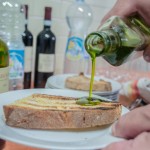
About The Author
Related Posts
And so we come to the end of our 2011 Food and Wine Tour, having…
Cipolloni Olive Oil Mill